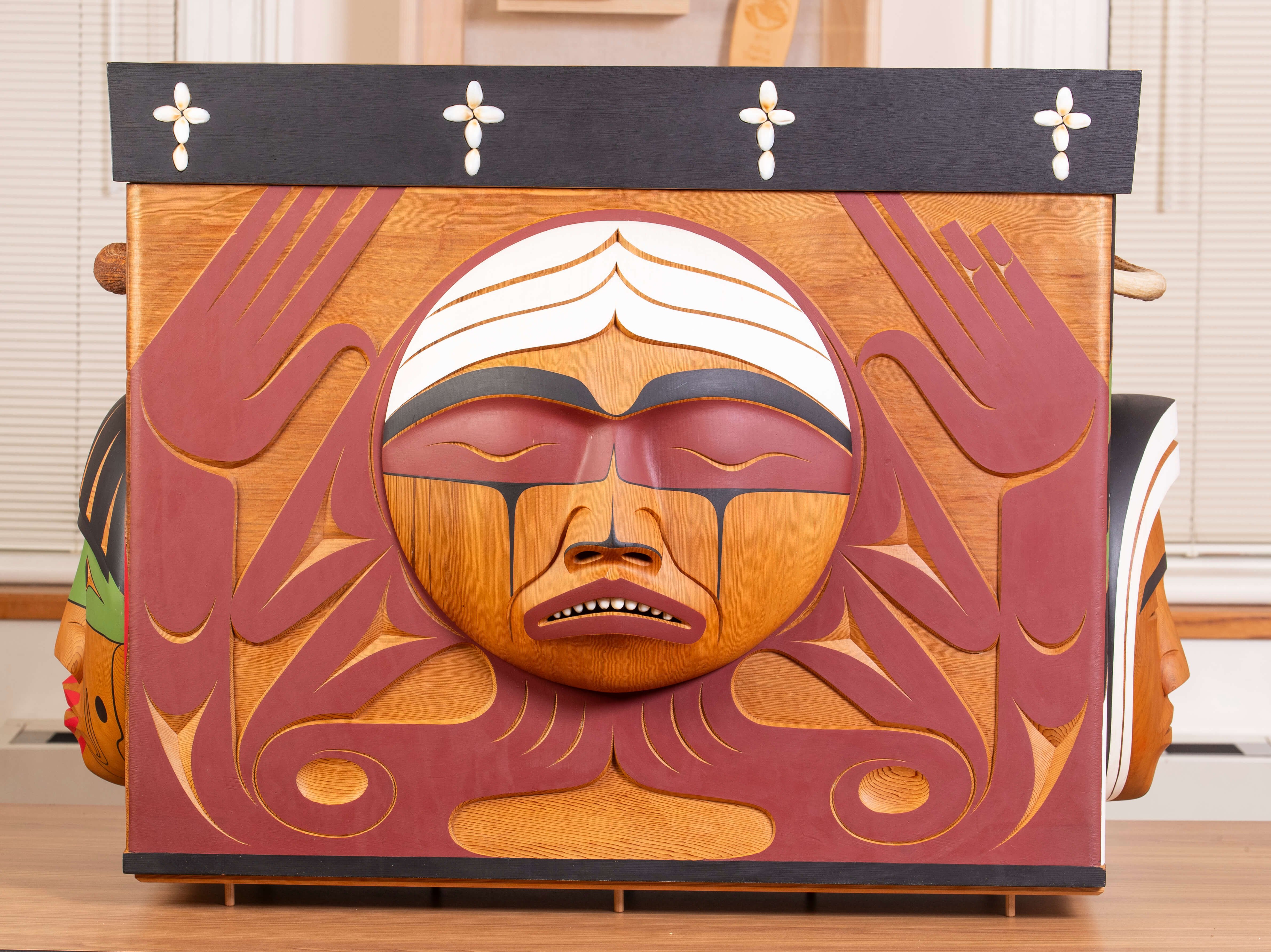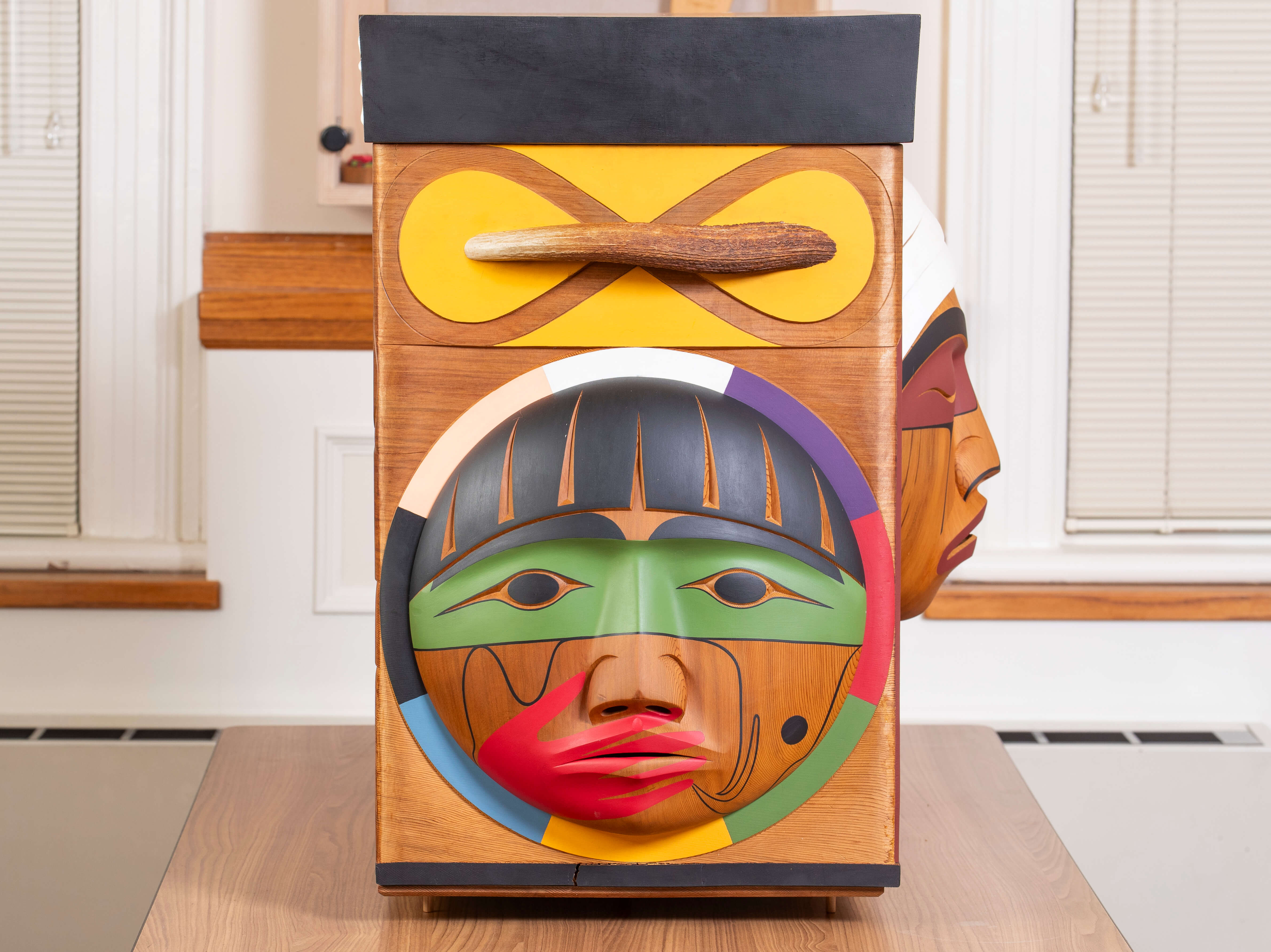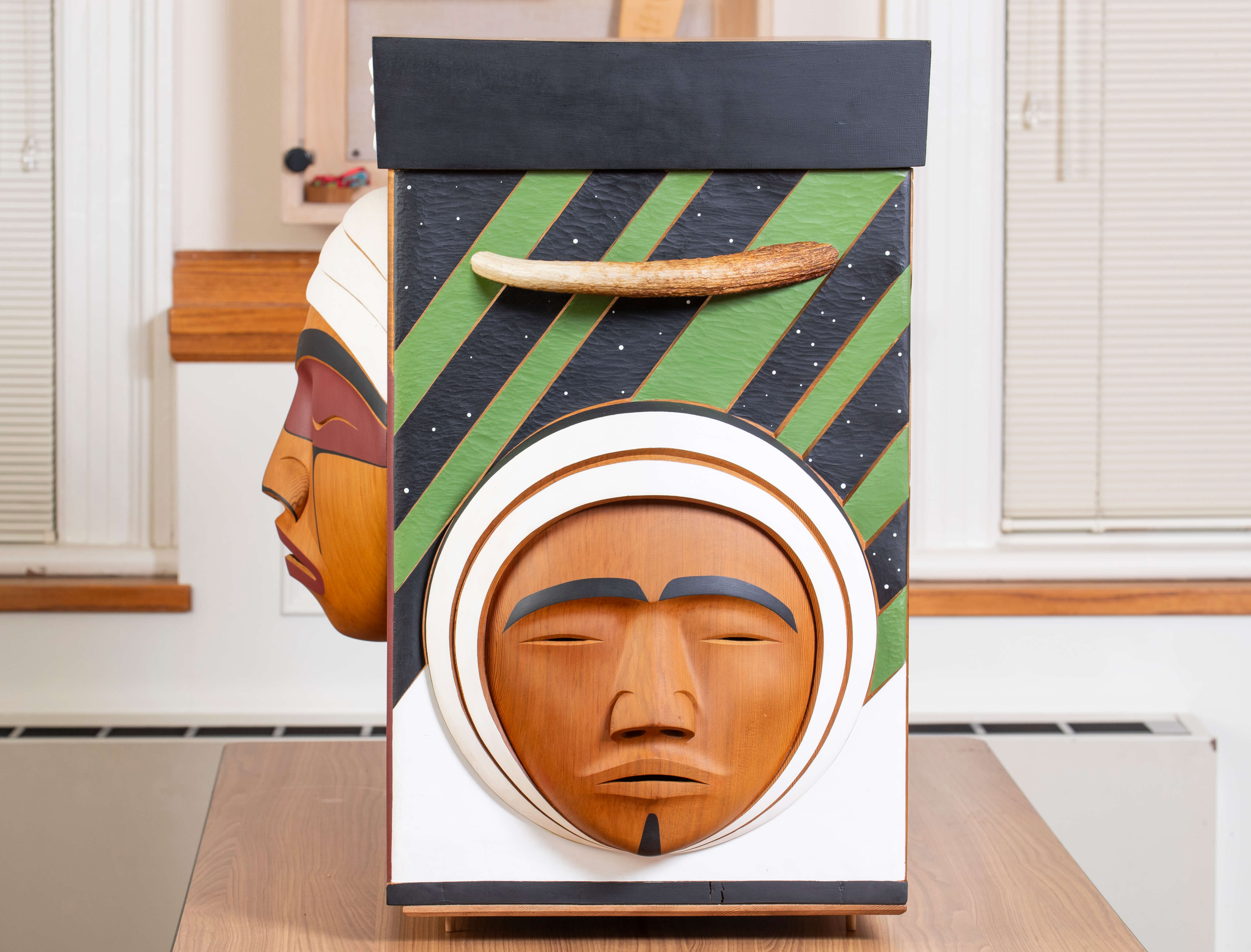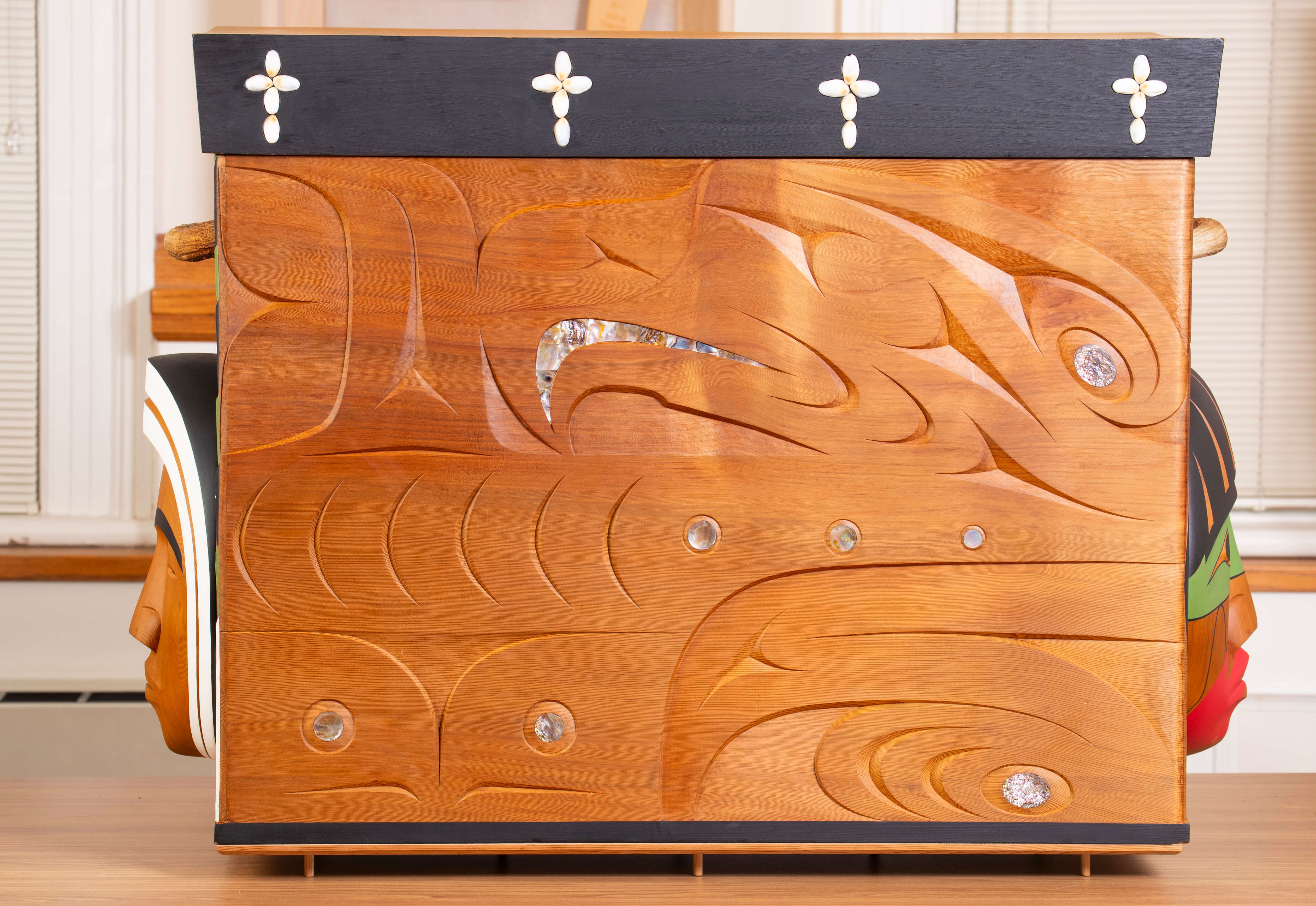The Gallery
The gallery space at the National Centre for Truth and Reconciliation (NCTR) is the heart of our building. More than just an exhibition area, it serves as a sacred gathering place for ceremonies, a collaborative environment for staff, and a welcoming space for guests, tours, and educational engagements. Within these walls, we respectfully display many of the sacred items entrusted to our care—tangible connections to the history and enduring legacy of the residential school system that powerfully bring these truths to life.
We invite you to learn more about some of the items displayed in our gallery below:
- Painting by Richard Shorty
- Inuit Tapiriit Kanatami Publication “First Canadians, Canadians First: The National Strategy on Inuit Education”
- Spirit Canoe, Expression of Reconciliation – Paddle, and Mini Bentwood Box
- The Walking Stick, Truth and Reconciliation Commission of Canada Eagle Staff, and Eagle Staff
- The Paddle
- The Bentwood Box
- Float Plane Painting by Don Ningewance
- Woven Basket
- Expression of Reconciliation – Paddle and Cedar Box
- Beaded Basket
- Qulliq
- Damaged Heart Diary
- Expression of Reconciliation – Wampum belt and Small Birch Bark Container
Painting by Richard Shorty
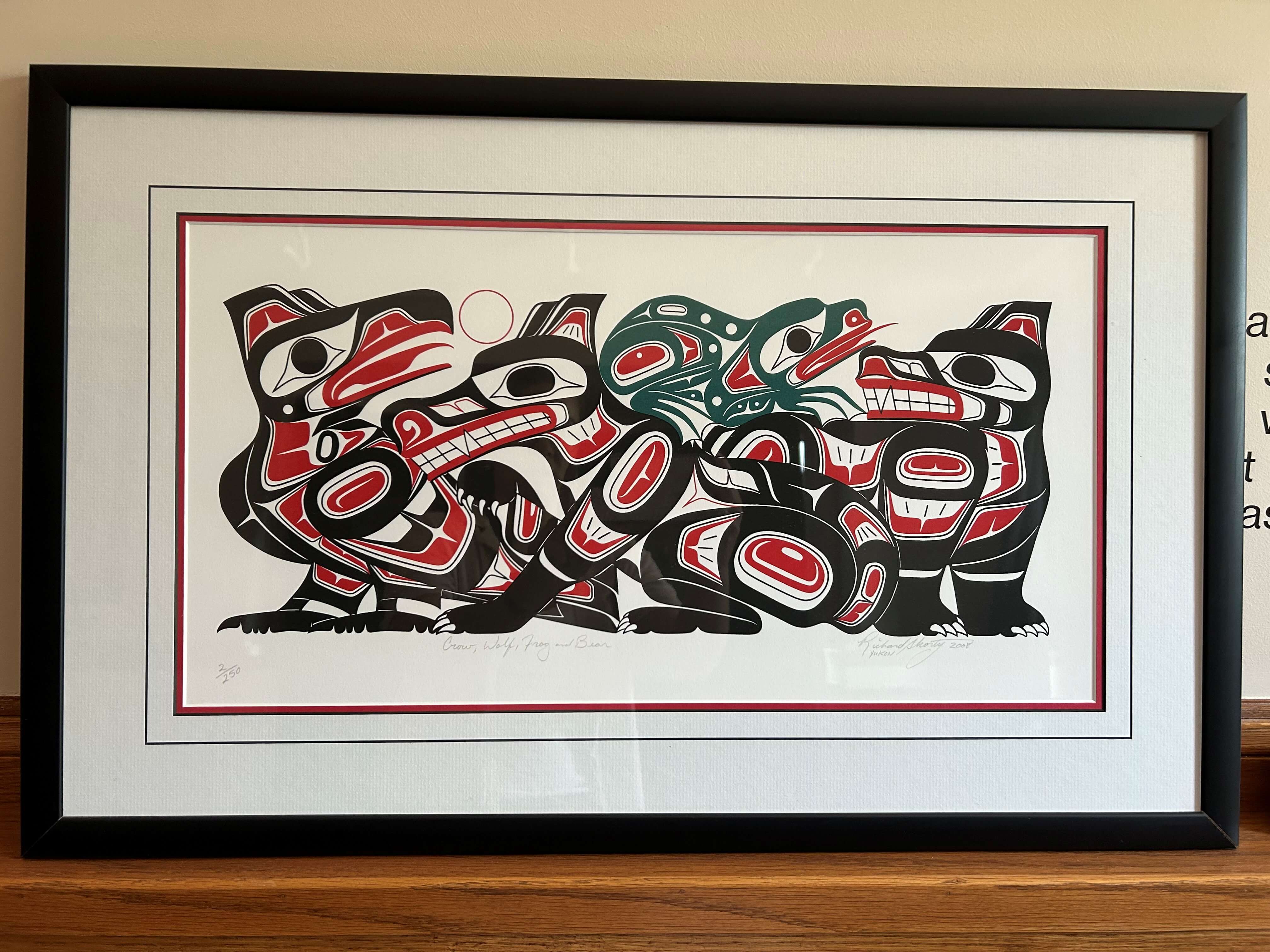
Richard Shorty, born in 1959 into the Southern Tutchone First Nation and raised in Whitehorse, began his career as a graphic artist in Vancouver in 1978. By 1980, he started incorporating Indigenous designs into his work, developing a unique style that blends traditional and contemporary elements. A versatile artist, Shorty’s work spans drums, paddles, masks, and rattles, and his pieces are collected nationwide.
His painting “Totem” features a specific order of clans, each with symbolic meaning: the Raven (crow), representing the bearer of light; the Wolf, symbolizing a good provider; the Bear, signifying strength and courage; and the Frog, representing its connection to the land and water of the earth.
Inuit Tapiriit Kanatami Publication “First Canadians, Canadians First: The National Strategy on Inuit Education”
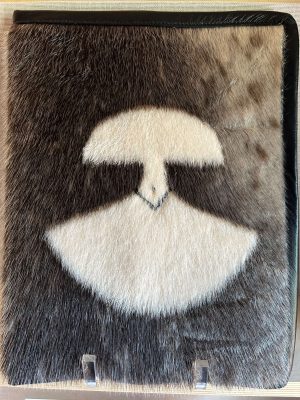
A copy of “First Canadians, Canadians First: the National Strategy on Inuit Education” (2011) by Inuit Tapiriit Kanatami (ITK), presented at the Alberta National Event on March 29, 2014. The publication is housed in a distinctive black leather and sealskin folder, with a patch sewn on the inside that reads, “Kiluk, LTD in Arviat, Nunavut”.
The front page bears a personal inscription from Mary Simon, then president of ITK, in both Inuktitut and English. During her presentation with Looee Okalik and Kelly Fraser, Ms. Simon emphasized two of the publication’s ten recommendations: the importance of parental engagement in children’s education and the provision of early childhood education in Inuit language and culture. Mary Simon, a prominent advocate for Inuit rights and reconciliation, also served as Co-Policy Director for the Royal Commission on Aboriginal Peoples, chaired the High Arctic Exiles hearings, and accepted the federal government’s apology to Inuit peoples in 2008.
NCTR Archives: Related Records
Spirit Canoe, Expression of Reconciliation – Paddle, and Mini Bentwood Box
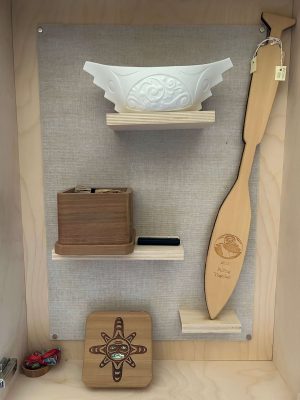
Spirit Canoe
“Spirit Canoe III” is a porcelain canoe created by First Nation artist Terry Jackson of Vancouver. This piece, named “Spirit Canoe,” was chosen to reflect the “Yuhaddax” (steering) theme of the Native Ministries Program steering committee. Presented by Reverend Mary Fontaine and Reverend Lily Bell on behalf of the Vancouver School of Theology, it was gifted at the British Columbia National Event in Vancouver on September 19, 2013, and is accompanied by a decorative box.
NCTR Archives: Related Records
Expression of Reconciliation – Paddle
This paddle was presented by Jolene Andrew and Linda Blake at the British Columbia National Event in Vancouver in September 2013, symbolizing the Pulling Together Canoe Society’s dedication to reconciliation.
NCTR Archives: Related Records
Mini Bentwood Box
A mini bentwood box, carved by Coast Salish artist Shane Jackson of Sechelt First Nation, featuring a sun mask symbolizing strength, healing, and growth as the Earth’s guardian by day. Originally, the box contained a flash drive, surrounded by sweetgrass, holding documents on Indigenous children aged 4-19 who died in British Columbia between 1870 and 1984, intended for missing children and unmarked burial research. However, the USB drive has since been removed, following an Elder’s instruction that it be surrounded by sage, tobacco, and cedar. The box was presented by Petter Cunningham on behalf of the Government of British Columbia and the Vital Statistics Agency of British Columbia at the Alberta National Event on March 28, 2014.
NCTR Archives: Related Records
The Walking Stick, Truth and Reconciliation Commission of Canada Eagle Staff, and Eagle Staff
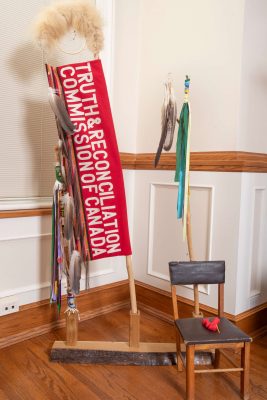
The Walking Stick
In 2015, during the first National Building Reconciliation Forum hosted by the University of Saskatchewan, Chancellor Blaine Favel commissioned a significant symbol of commitment from post-secondary institutions to the TRC’s Calls to Action. Elder Eugene Arcand tasked Lodge Keeper Wallace Fox of the Onion Lake Cree Nation to create this symbol: a Walking Stick. Described as “a companion, a protector, and an educational tool in pow-wow circles,” the Walking Stick serves as a tangible representation of reconciliation efforts.
The Walking Stick has since been passed between host universities at subsequent forums, beginning with the University of Alberta in 2016, followed by the University of Manitoba in 2017, and the University of Victoria in 2018. Each of these four host universities is commemorated with a unique beaded crest on the Walking Stick, signifying their dedication to reconciliation. Following its journey through these institutions, the Walking Stick was ultimately presented to the National Centre for Truth and Reconciliation.
Truth and Reconciliation Commission of Canada Eagle Staff
Commissioned for the Truth and Reconciliation Commission of Canada.
Eagle Staff
In 2010, the late Patrick Etherington Jr., alongside his father Patrick Etherington Sr. and three others (Frances Whiskeychan, Christopher Paulmartin, and Jorge Hookimaw’lliller), embarked on a 1,400 km “Reconciliation Walk” from Cochrane, ON, to Winnipeg to attend the first TRC National Event. Known as the Reconciliation Walkers, or the TRC Walkers, Mushkegowuk Walkers, and Oskapewisk (The Helpers), their journey aimed to raise public awareness about the plight of Survivors and the residential school system. During the event, Patrick Jr. gifted an eagle staff to the Commissioners on behalf of the group, symbolizing their commitment to healing and closing the painful chapter opened by the schools.
The Reconciliation Walkers continued their advocacy, with Patrick Jr. and Sr. participating in subsequent walks. In 2011, joined by four others (Frances Whiskeychan, Robert Hunter, James Kioke, and Sammy Koosees), they walked 2,200 km over 42 days to attend the Atlantic National Event in Halifax, a journey Patrick Jr. described as humbling in comparison to the suffering of Survivors. They also walked to the Toronto Regional Event in 2012, and in 2015, they completed their final walk to the TRC closing ceremonies in Ottawa, joined by five additional individuals (Frances Whiskeychan, Maurice Wesley, Remi Nakogee, Darren Hughie, and Edmund Etherington). Through these powerful acts, the Reconciliation Walkers sought to educate Canadians about the truths of residential schools and the potential for meaningful dialogue and inclusive education in the path toward reconciliation.
The Paddle

In 2019, the University of Victoria introduced a new symbol for the Building Reconciliation Forum and presented it at the 5th forum (Oct 8-10, 2019) hosted by Algoma University, the Shingwauk Kinoomaage Gamig Institute, Cape Breton University, Nipissing University, and the University of Northern British Columbia. The symbol consists of three distinct paddles, all carved by Kwagiulth and Coast Salish artist Carey Newman, with designs contributed by artists from various generations and nations. Each paddle carries unique significance: one, painted by residential school Survivor Victor Newman, is destined to accompany the Walking Stick at the NCTR; another, carved and painted by students Karver Everson and Margaret August, remains at the University of Victoria as a reminder of their commitment to reconciliation. The third paddle, carved by Carey Newman, features a map on its handle symbolizing interconnectedness, with its blade left blank for future host institutions to contribute to.
These three paddles collectively represent the idea that “we are all in this together as we heal the past, present and future,” forging a ceremonial bond between the NCTR, the University of Victoria, and the ongoing work of Truth and Reconciliation. The tradition of passing a symbolic item continued in 2021 with the 6th forum (Sep 21-23, 2021), where a pair of moccasins crafted by Marie-Claude Moreau became the new symbol, representing “Falling into step with First Peoples students.”
Float Plane Painting by Don Ningewance
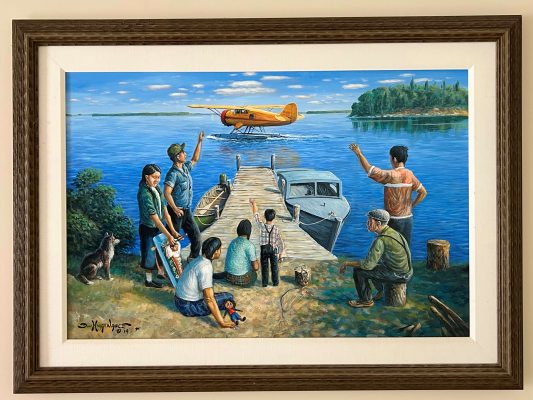
This colourful painting depicts children being taken to residential school by float plane, with a doll and slingshot symbolizing their abandoned childhoods. The artwork, which originally hung in the TRC office on Main Street, was created by the uncle of former Survivor Circle member Garnet Angeconeb, and his family is depicted within the scene.
Woven Basket
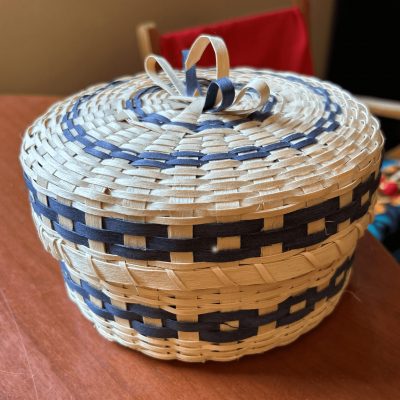
A woven basket gifted by Elder Claudette Commanda from the McLean Day Schools Settlement Corporation during a visit to the NCTR on November 21st, 2023. The purpose of the visit was for the McLean Corporation to learn about the NCTR’s operations and gain insights from our work.
Expression of Reconciliation – Paddle and Cedar Box
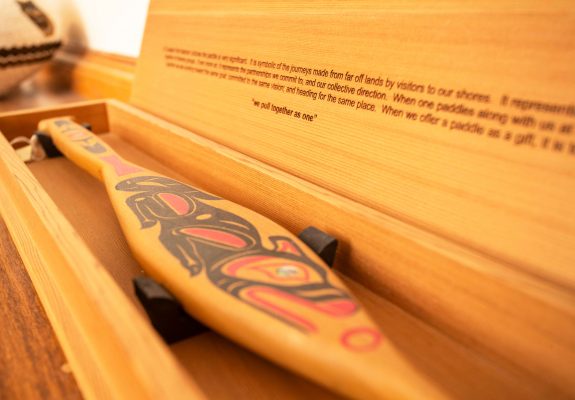
This item consists of a paddle and a cedar box designed to contain it, with the box’s lid featuring an inscription detailing the paddle’s symbolism and meaning. A second, related paddle is also on display in the Gallery at the NCTR. Both were presented by Jolene Andrew and Linda Blake on behalf of the Pulling Together Canoe Society at the British Columbia National Event in Vancouver in September 2013, symbolizing the Society’s commitment to reconciliation.
NCTR Archives: Related Records
Beaded Basket
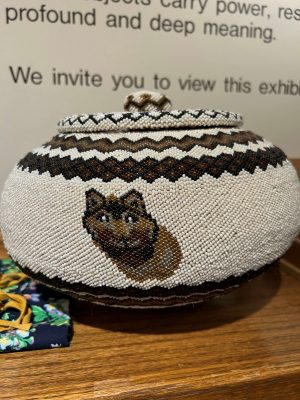
This basket held the ashes of all the sacred fires from the TRC national events. After each event, the ashes were collected and incorporated into the sacred fire at the subsequent event.
Qulliq
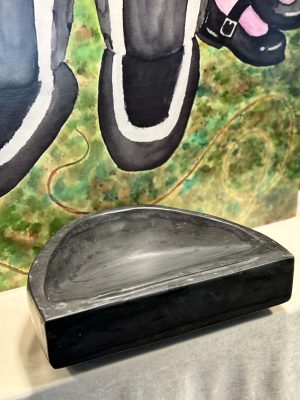
This qulliq, a traditional Inuit lamp providing light and warmth, is crafted from Sanikiluaq marble, though they are also commonly made from soapstone. Its design features a carved vessel for oil and a ridge to hold a wick, traditionally made from arctic cotton and moss, using whale blubber as fuel. Once lit, it produces a long-lasting flame for cooking, drying clothes, and providing heat and illumination, tended with a hook-shaped taqqut tool. This particular qulliq travels with the NCTR, lit at ceremonies and special events to symbolize Inuit strength and enduring spirit, guiding diverse healing journeys.
The qulliq was created by renowned stone sculptor Kupapik Ningeocheak from Rankin Inlet, known for his unique abstract sculptures, figures, and animals, often blending human and animal characteristics in transformation scenes. Ningeocheak, who learned from older artists like Alex Alikasuak and George Arluk in the mid-1990s, has developed a distinctive style marked by works of incredible mass and presence, with mysterious faces on his transformation figures. This qulliq was acquired by the NCTR in March 2024 from Carvings Nunavut, a 100% Inuit-owned company in Iqaluit, owned by respected entrepreneur Lori Idlout, who is dedicated to preserving Inuit values.
Damaged Heart Diary
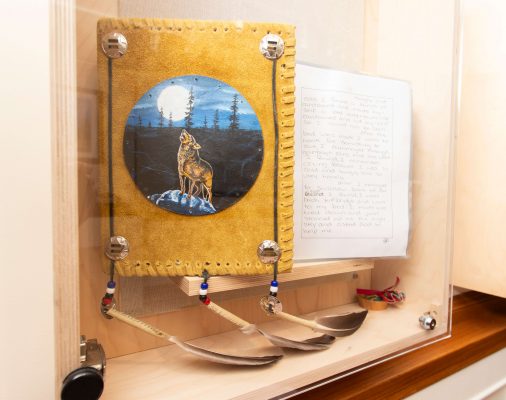
This item is a leather-bound book adorned with eagle feathers, containing the handwritten life story and residential school remembrances of Stanley Normand from Sagkeeng First Nation, a Survivor of Fort Alexander Indian Residential School. To protect its delicate, unbound pages, they have been carefully placed in protective sleeves and secured with rubber bands.
Expression of Reconciliation – Wampum belt and Small Birch Bark Container
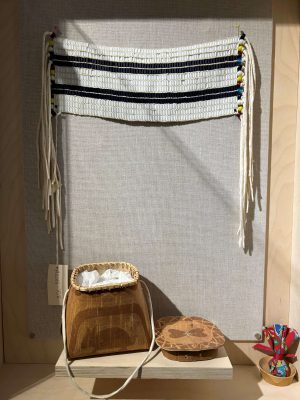
Expression of Reconciliation – Wampum belt
This wampum belt was presented by John and Nancy Denham at the British Columbia National Event in Vancouver on September 20, 2013. Their presentation, titled “Gesture of Reconciliation,” accompanied the gifting of this significant item.
NCTR Archives: Related Records
Small Birch Bark Container
This basket, which contains a declaration, was created in 2013 and contributed to the TRC by the Sioux Lookout Coalition on Healing and Reconciliation. It depicts stylized animals including a bird, butterfly, and a rabbit.
NCTR’s spirit name – bezhig miigwan, meaning “one feather”.
Bezhig miigwan calls upon us to see each Survivor coming to the NCTR as a single eagle feather and to show those Survivors the same respect and attention an eagle feather deserves. It also teaches we are all in this together — we are all one, connected, and it is vital to work together to achieve reconciliation.

